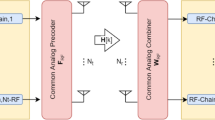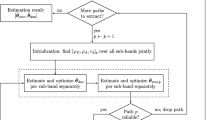Abstract
A comprehensive analytical bit-error-rate (BER) model is presented to analyse the performance of antenna-microdiversity for wideband BPSK modulated signals in the frequency selective fading multipath channel, specified by its complex impulse response. The model includes the disturbance by intersymbol interference (ISI) and co-channel interference (CCI), as well as the channels' impact on the carrier phase- and clock recovery in the receiver. The channel impulse responses at the antenna elements are determined by taking into account the direction of arrival of the individual paths. Computational BER- and SNIR-gain results (SNIR = signal-to-noise+interference-ratio) show that a substantial performance improvement is achieved with antenna combining for wideband signals which suffer ISI and/or CCI. For the indoor multipath channel with exponentially decaying power delay profile, the performance enhancement is compared for several antenna combining schemes. Quasi-coherent equal gain combining (QCEGC) is proposed as an novel EGC scheme based on a less accurate phase estimation technique. For wideband signals, QCEGC shows a slight performance degradation when compared to maximal ratio combining or minimum mean square error combining (MMSEC), but has a much lower implementation complexity. In the channel with CCI, where the best performance is achieved with MMSEC, QCEGC performs very poor.
Similar content being viewed by others
References
K. Pahlavan, T.H. Probert and M.E. Chase, “Trends in Local Wireless Networks”, IEEE Commun.Mag., Vol. 33, No. 3, pp 88–95, 1995.
S.Y. Seidel and T.S. Rappaport, “Path-Loss Prediction in Multifloored Buildings at 914 MHz”, Electronics Letters, Vol. 27, No. 15, pp 1384–1387, 1991.
H. Hashemi, “The Indoor Propagation Channel”, in Proc.IEEE, Vol. 81, No. 7, July 1993, pp 943–968.
D.G. Brennan, “Linear Diversity Combining Techniques”, in Proc.IRE, June 1959, pp 1075–1102.
A.A. Abu-Dayya and N.C. Beaulieu, “Micro-and Macrodiversity NCFSK (DPSK) on Shadowed Nakagami-Fading Channels”, IEEE Trans.on Commun., Vol. 42, No. 9, pp 2693–2702, 1994.
J.H. Winters, “Optimum Combining in Digital Mobile Radio with Co-Channel Interference”, IEEE Journ. on Sel.Areas in Comm., Vol. SAC-2, No. 4, pp 528–539, 1984.
A.A. Abu-Dayya and N.C. Beaulieu, “Micro-and Macrodiversity MDPSK on Shadowed Frequency-Selective Channels”, IEEE Trans.on Commun., Vol. 43, No. 8, pp 2334–2343, 1995.
M.V. Clark, L.J. Greenstein, W.K. Kennedy and M. Shafi, “MMSE Diversity Combining for Wideband Digital Cellular Radio”, IEEE Trans.on Comm., Vol. 40, No. 6, pp 1128–1135, 1992.
G.J.M. Janssen, P.A. Stigter and R. Prasad, “A Model for Bit Error Rate Evaluation of Indoor Frequency Selective Channels Using Multipath Measurement Results at 2.4, 4.75 and 11.5 GHz”, Int. Zürich Seminar on Mobile Comm., Lect. Notes in Comp. Sc. 783, March 1994, pp 344–355.
G.J.M. Janssen, P.A. Stigter and R. Prasad, “Wideband Indoor Channel Measurements and BER Analysis of Frequency Selective Multipath Channels at 2.4, 4.75 and 11.5 GHz”, IEEE Trans.on Commun., Vol. 44, No. 10, pp 1272–1288, 1996.
H. Hashemi, “Impulse Response Modelling of Indoor Radio Propagation Channels”, IEEE JSAC, Vol. SAC-11, pp 967–978, 1993.
B. Glance and L.J. Greenstein, “Frequency-Selective Fading Effects in Digital Mobile Radio with Diversity Combining”, IEEE Trans.on Comm., Vol. 31, No. 9, pp 1085–1094, 1983.
J. C-I. Chuang, “The Effects ofMultipath Delay Spread on Timing Recovery”, IEEE Trans.on Vehic.Techn., Vol. 35, No. 3, pp 135–140, 1987.
F. van der Wijk, A. Kegel and R. Prasad, “Assessment of a Pico-Cellular System Using Propagation Measurements at 1.9 GHz for Indoor Wireless Communications”, IEEE Trans.on Veh.Techn., Vol. 44, No. 1, pp. 155–162, 1995.
A.A.M. Saleh and R.A. Valenzuela, “A Statistical Model for Indoor Multipath Propagation”, IEEE JSAC, Vol. SAC-5, No. 2, pp 128–137, 1987.
A. Klein and W. Mohr, “A Statistical Wideband Mobile Radio Channel Model Including the Directions-of-Arrival”, in Proc.IEEE ISSSTA'96, Mainz, September 1996, pp 102–106.
G.J.M. Janssen, “Performance Enhancement of Indoor Channels Using Quasi-Coherent Combining of Multiple Antenna Signals”, in Proc.7th Int.Therrenian Workshop on Digital Communications, Italy, September 1995, pp 15–26.
G.J.M. Janssen, “Dual-Signal Receiver Structures for Simultaneous Reception of Two BPSK Modulated Co-Channel Signals Using Signal Cancellation”, Wireless Personal Communications, Vol. 1, No. 1, pp 43–59, 1994.
S. Haykin,Adaptive Filter Theory, Prentice Hall, Inc., 1991.
Author information
Authors and Affiliations
Rights and permissions
About this article
Cite this article
Janssen, G.J. Performance Improvement by Microdiversity for Wideband Signals in Frequency Selective Fading Indoor Channels with Co-Channel Interference. Wireless Personal Communications 11, 313–333 (1999). https://doi.org/10.1023/A:1018680824808
Issue Date:
DOI: https://doi.org/10.1023/A:1018680824808




